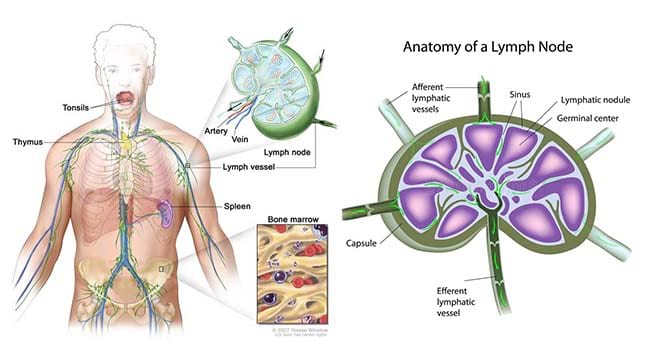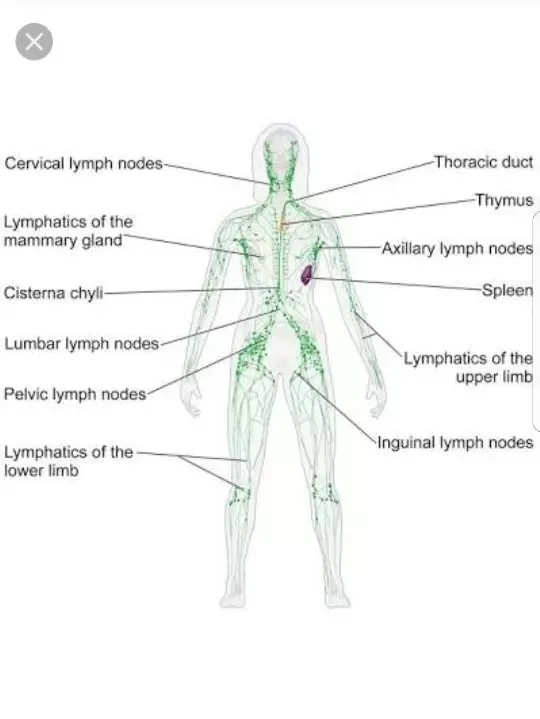The lymph vessels carry a clear fluid called lymph that is collected from tissues throughout the body. In this article we will discuss the location and function of this immune system organ.
The lymphatic system.
. Lymph nodes are bean-shaped structures about 01 25 cm in length. They are the soldiers of the body and form an important first line of defense. At approximately 01 by 25 cm the lymph node is a relatively small glandular structure that resembles a kidney-bean.
Lymph nodes are specialized masses of tissue that are situated along lymphatic system pathways. The lymphatic system drains the lymph extra fluid leaking from the body tissues and returns it to the blood system. Draining the lymph from the tissues.
Small oval bodies of the lymphatic system distributed along the lymphatic vessels clustered in the armpits groin neck chest and abdomen. The node is enclosed in a capsule and has an indentation on one surface along one of its long axes known as the hilum. Internodular region rich in T-cells and post-capillary venules 4.
These nodes swell in. Filtering of the lymph helps in removal of particles not normally found in the serum. Absorbing fats from the digestive tract.
The cortex paracortex and medulla. These structures filter lymph fluid before returning it to the blood. Lymph nodes lymph vessels and other lymphatic organs help to prevent fluid build-up in tissues defend against infection and maintain normal blood volume and pressure in the body.
Lymph is a fluid connective tissue that flows inside the specialised vessels known as lymphatic vessels. There are 500600 lymph nodes throughout the body. The medulla consists of the medullary sinuses and the medullary cords which contain lymphocytes plasma cells and macrophages.
The primary role of the lymph node is to filter the lymph and then produce an immune response against trapped microbesantigens. Lymph nodes are important for the proper functioning of the immune system acting as filters for foreign particles and cancer cells but they do not have a detoxification functionIn the lymphatic system a lymph node is a secondary lymphoid organ. Lymph nodes or lymph glands are small lumps of tissue that contain white blood cells which fight infection.
The hilum is the point at which arteries carrying nutrients and lymphocytes enter the lymph node and veins leave it. The lymph that is filtered is then returned to the blood to prevent edema or the excess fluid buildup in the tissues. The spleen tonsils adenoids and thymus all form a part of the lymphatic system.
They help fight infections and also play an important role in cancer diagnosis treatment and the. Dome elevated region overlying the lymphatic nodule. It is a colourless fluid that is a part of the tissue fluid that in turn is a part of the blood plasma.
Lymph nodes are the organs responsible for the functioning of immune system. Definition and Function of Lymph Nodes in the Body. Lymphoid tissue contains lymphocytes and other specialized cells and tissues that have immune system functions.
If the fluid does not get drained it results in edema swelling over the body. Along the lymph channels reside approximately 600 lymph nodes. Filter out the bad stuff- remove and destroy microorganisms and remove debris from the lymph so all the bad is filtered out before returning to the bloodstream.
They are major sites of B and T cells and other white blood cells. The spleen is considered the largest lymphatic organ in the system which is located under the ribcage above the stomach and exactly in. The lymphatic system consists of the lymph nodes spleen thymus as well as the lymphatic tissue found in the small intestine Peyers patches and throat adenoid tonsils palatine tubal tonsils It is a part of your immune system It has many functions It can protect your body from illness-causing invaders maintain body fluid levels absorb digestive tract fats.
It has a convexed surface that is penetrated by afferent lymph vesselsOn the opposing side there is a concavity that is penetrated by the supplying artery vein and nerve and also allows exit of efferent lymphatic vessels. They are small bean shaped glands present throughout the body either single or in clusters. They are located in groups mostly in the neck armpit collarbone and groin.
Lymph contains cell wastes like cancer cells bacteria and viruses. Villi and crypts are sometimes absent in epithelium 5. Functions of Lymph Nodes.
The lymphatic system circulates the. Lymph nodes are located at intervals along the lymphatic system. In the paracortex T cells predominate.
The main achievement of the development of lymph nodes in mammals is a drastic improvement for the production of better antibodies. The lymph nodes are small bean shaped glands or bulbs that tend to occur in clusters much like grapes. The lymph gets filtered at the lymph nodes.
The lymphoide tissues in the nodes break down materials which have been filtered off such as. 5 main functions of the lymphatic system. The lymph node with its high concentration of lymphocytes and antigen-presenting cells is an ideal organ for receiving antigens that gain access through the skin or.
Lymph nodes are small bean-shaped organs of the lymphatic system. Everyone has an extensive lymphatic system in their body which consists of lymph nodes and lymph vessels. They are part of the bodys immune system and filter lymph fluid which is composed of fluid and waste products from body tissues.
Their main function is to trap the bacteria and viruses from the lymph fluid which flows through them. Describe the general location histological structure and functions of lymph nodes. Mantle or corona zone of small lymphocytes that caps the lymphatic nodule 3.
The lymph contains very small amounts of nutrients and oxygen but contains abundant carbon dioxide and other metabolic wastes as. Lymph nodes are a part of the lymphatic system of the body. The lymph node can be separated into three cellular compartments.
T cells on the other hand have not changed their function much. The cortex contains lymphoid follicles composed mostly of B cells. The lymphatic system is a network of vessels nodes and ducts that collect and circulate excess fluid in the body.
These act as filters that.

Lymph Nodes Structure And Functions

How To Describe The Functions Of The Lymphatic System Quora

Anatomy Physiology Of Lymph Nodes Youtube
What Are The Functions Of Lymph Vessels Would It Make A Huge Difference If They Weren T There Quora

0 Comments